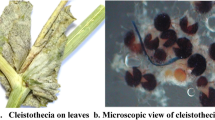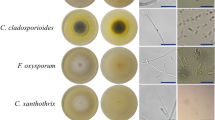Abstract
Until recently, Erysiphe pisi was thought to be the only causal agent of powdery mildew in pea, but recent studies showed that other species such as Erysiphe trifolii and Erysiphe baeumleri can also cause this disease. Three genes, er1, er2 and Er3, conferring resistance to E. pisi have been reported so far in pea. Previous studies showed that E. trifolii and E. baeumleri were able to overcome er1 resistance, but whether er2 and Er3 were effective against E. trifolii was not known. In this study, pea accessions carrying these three genes were evaluated for resistance to E. trifolii under controlled conditions at 20 and 25 °C. In addition, these accessions were also evaluated under field conditions in Spain and in India. Analysis of the ribosomal DNA (rDNA) internal transcribed spacer (ITS) sequences showed that E. trifolii was the causal agent of powdery mildew symptoms in lines carrying er1 in Spain and that this pathogen was also present in India. Our results showed that E. trifolii was able to overcome er1 and shows that this pathogen can also overcome Er3 resistance in some conditions. In contrast, er2 provided high level of resistance against E. trifolii in all conditions and locations studied. Temperature affected the expression of Er3 against E. trifolii, but not of er1 or er2. The pea accession JI2480, containing er2, was highly resistant and JI2302 containing er1 was susceptible to E. trifolii at both temperatures, whereas P660-4 containing Er3 was resistant at 20 °C but susceptible at 25 °C. The present study also identified sources of resistance effective against both E. pisi and E. trifolii.


Similar content being viewed by others
References
Attanayake, R. N., Glawe, D. A., Dugan, F. M., & Chen, W. (2009). Erysiphe trifolii causing powdery mildew in lentil (Lens culinaris). Plant Disease, 93(8), 797–803.
Attanayake, R. N., Glawe, D. A., McPhee, K. E., Dugan, F. M., & Chen, W. (2010). Erysiphe trifolii—a newly recognized powdery mildew pathogen of pea. Plant Pathology, 59, 712–720.
Barilli, E., Sillero, J. C., Serrano, A., & Rubiales, D. (2009). Differential response of pea (Pisum sativum) to rusts incited by Uromyces viciae-fabae and U. pisi. Crop Protection, 28, 980–986.
Braun, U (1995) The powdery mildews (Erysiphales) of Europe. New York, USA: Gustav Fischer Verlag.
Cunnington, J. H., Takamatsu, S., Lawrie, A. C., & Pascoe, I. G. (2003). Molecular identification of anamorphic powdery mildew fungi. Australasian Plant Pathology, 32, 421–428.
Fondevilla, S., Carver, T. L. W., Moreno, M. T., & Rubiales, D. (2006). Macroscopic and histological characterisation of genes er1 and er2 for powdery mildew resistance in pea. European Journal of Plant Pathology, 115, 309–321.
Fondevilla, S., Carver, T. L. W., Moreno, M. T., & Rubiales, D. (2007). Identification and characterisation of sources of resistance to Erysiphe pisi Syd. in Pisum spp. Plant Breeding, 126, 113–119.
Fondevilla, S., Cubero, J. I., & Rubiales, D. (2010). Confirmation that the Er3 gene, conferring resistance to Erysiphe pisi in pea, is a different gene from er1 and er2 genes. Plant Breeding, 130, 281–282.
Gritton, E. T., & Ebert, R. D. (1975). Interaction of planting date and powdery mildew on pea plant performance. Journal of the American Society for Horticultural Science, 100, 137–142.
Gupta, R. P., & Singh, R. N. (2007). Mechanism of slow mildewing by Erysiphe pisi (Syd) and stability of resistance in pea (Pisum sativum L.). Proceedings of the National Academy of Sciences India, Section B, Biological Sciences, 77(4), 423–426.
Harland, S. C. (1948). Inheritance of immunity to mildew in Peruvian forms of Pisum sativum. Heredity, 2, 263–269.
Heringa, R. J., Van Norel, A., & Tazelaar, M. F. (1969). Resistance to powdery mildew (Erysiphe polygoni D.C.) in peas (Pisum sativum L.). Euphytica, 18, 163–169.
Kushwaha, C., Chand, R., & Srivastava, C. (2006). Role of aeciospores in outbreaks of pea (Pisum sativum) rust (Uromyces fabae). European Journal of Plant Pathology, 115, 323–330.
Little, T. M., & Hills, F. J. (1972). Statistical methods in agriculture research. Agricultural Extension: University of California.
Ondřej, M., Dostálová, R., & Odstrčilová, L. (2005). Response of Pisum sativum germplasm resistant to Erysiphe pisi to inoculation with Erysiphe baeumleri, a new pathogen of peas. Plant Protection Science, 41, 95–103.
Ram, B., & Prasad, C. S. (1994). Assessment of losses by powdery mildew, Erysiphe polygoni (DC) on pea. National Academy Science Letters, 17, 175–177.
Saenz, G. S., & Taylor, J. W. (1999). Phylogeny of the Erysiphales (powdery mildews) inferred from internal transcribed spacers ribosomal DNA sequences. Canadian Journal of Botany, 77(1), 150–168.
Singh, R. A., De, R. K., & Chaudhary, R. G. (2003). Stable resistance to powdery mildew in field pea. Indian Journal of Pulses Research, 16, 47–49.
Smith, P. H., Foster, E. M., Boyd, L. A., & Brown, J. K. M. (1996). The early development of Erysiphe pisi on Pisum sativum L. Plant Pathology, 45, 302–309.
Tiwari, K. R., Penner, G. A., Warkentin, T. D., & Rashid, R. Y. (1997a). Pathogenic variation in Erysiphe pisi, the causal organism of powdery mildew of pea. Canadian Journal of Plant Pathology, 19, 267–271.
Tiwari, K. R., Penner, G. A., & Warkentin, T. D. (1997b). Inheritance of powdery mildew resistance in pea. Canadian Journal of Plant Science, 77, 307–310.
Torres, A. M., Weeden, N. F., & Martín, A. (1993). Linkage among isozyme, RFLP and RAPD markers in Vicia faba. Theoretical and Applied Genetics, 85, 937–945.
Warkentin, T. D., Rashid, K. Y., & Xue, A. G. (1996). Fungicidal control of powdery mildew in field pea. Canadian Journal of Plant Science, 76, 933–935.
Acknowledgments
S. Fondevilla was granted by a contract funded by the Spanish JAEdoc program. Financial support from project AGL2011-22524 (co-financed by FEDER) is acknowledged.
Author information
Authors and Affiliations
Corresponding author
Rights and permissions
About this article
Cite this article
Fondevilla, S., Chattopadhyay, C., Khare, N. et al. Erysiphe trifolii is able to overcome er1 and Er3, but not er2, resistance genes in pea. Eur J Plant Pathol 136, 557–563 (2013). https://doi.org/10.1007/s10658-013-0187-6
Accepted:
Published:
Issue Date:
DOI: https://doi.org/10.1007/s10658-013-0187-6




